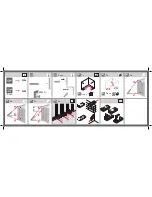
Section 5 — Sampling
EPS-16 PLUS Musician's Manual
Getting Ready to Sample
Here are a few things you can do before sampling anything that will result in your
getting better quality samples.
• Start with the cleanest possible signal — This may seem obvious, but a sample
(or any recording) can only be as good as the original signal, so you should pay
attention to the signal path. For example, if you are feeding the audio input of
the EPS-16 PLUS from a mixer, using a direct out from the individual channel
is better than using an auxiliary send because there are fewer preamps (and thus
less noise) in the chain. If you do use an auxiliary or a main send, make sure
only the channel(s) you intend to sample are turned up in that send.
• Record the sound on tape and sample from the tape — This is not always
possible, but it tends to yield better results because now the sound is repeatable.
This is important when adjusting the input level—before sampling you can play
the sound as many times as necessary, watching the meter and adjusting the
level of the signal into the EPS-16 PLUS, until you have just the right level—
high enough to get the best possible dynamic range, yet low enough to avoid
clipping. The other good reason for sampling from tape also has to do with
repeatability. Suppose you are sampling a horn section live, directly into the
EPS-16 PLUS, and suddenly they play that one excruciatingly perfect note that
you've been waiting for all your life. But after making the sample you discover
that the input level was a little too high and the sample is clipped Or you want
to put a slightly different EQ on it, or maybe some reverb. Unfortunately, you
will never get them to play that note just the same way again, so the moment is
lost. If you had it on tape you could simply make your adjustments and sample
it again.
Easy Sampling
Let's try a simple one-shot sample. First we need a source — a microphone,
synthesizer, the output of a mixer, etc. That sound source should be connected to
the Audio In jack of the EPS-16 PLUS. Note that the EPS-16 PLUS has no
separate level control on the input The level of the signal coming into the
EPS-16 PLUS must be adjusted at the source.
The EPS-16 PLUS' Audio Input can be switched to accept a line-level signal
(such as that from a mixer or a synthesizer), or a mic-level signal (from a
microphone). This is set after you enter the Level-Detect mode. To initiate
sampling:
5 - 4 Easy Sampling
Summary of Contents for EPS-16 PLUS
Page 1: ...DIGITAL SAMPLING WORKSTATION MODULE OCRed by nullp01nter ...
Page 3: ...EPS 16PLUS Digital Sampling Workstation Module Musician s Manual Version 1 1 ...
Page 44: ...Section 1 Getting Started EPS 16 PLUS Musician s Manual 1 28 ...
Page 144: ...This page intentionally left blank 6 28 ...
Page 258: ......
















































